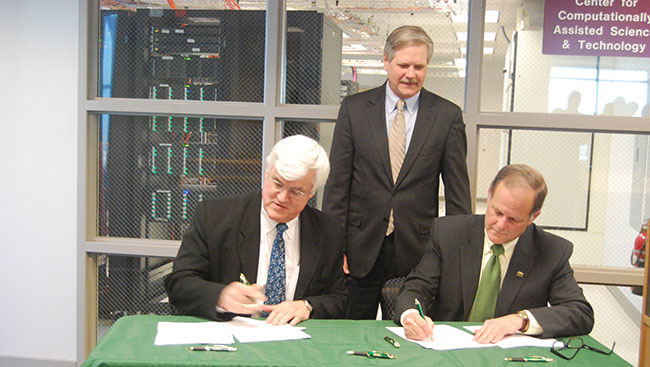Laboratory partners with North Dakota State University in energy research
 (Download Image)
(Download Image)
LLNL Director Parney Albright and North Dakota State University President Dean Bresciani sign a partnership agreement as U.S. Sen. John Hoeven looks on.
NDSU President Dean Bresciani and LLNL Director Parney Albright finalized the agreement at a signing ceremony at NDSU on Dec. 14.
Collaboration between the national lab and NDSU's advanced computing capabilities through the NDSU Center for Computationally Assisted Science and Technology (CCAST) is expected to lead to opportunities for NDSU students and faculty participating in the R&D partnership.
"The energy challenges of today and tomorrow require new kinds of partnerships to develop and use new kinds of technology," Albright said. "We look forward to a close partnership with NDSU faculty, staff and students bringing advanced supercomputing to real world problems in fossil energy and sustainability."
"Collaboration between NDSU and LLNL is expected to include faculty, staff and students on research projects, once funding is secured," Bresciani said. "This will provide a tremendous opportunity for students to gain experience in the use of advanced supercomputers for science and technology development."
Potential research may include enhancing productivity for tightly-bound liquid hydrocarbons, such as those found in the Bakken oil shale formation in North Dakota. Other potential research projects could include high-throughput chemical design and development of new, novel materials for energy applications.
The research partners plan to develop and refine high performance computer-based simulators of reservoirs of tightly bound hydrocarbons such as oil and gas found in shale formations. In collaboration, the partners plan to seek funding for projects to harness the power of advanced supercomputing to develop new materials and methodologies for robotic-driven rapid experimentation. Upon securing funding, the research team plans to design and evaluate potential catalysts for commercial energy applications. Such research may include gas-to-liquid fuel catalysts, gas separations processes and energy conversion. Research may include design of new functional polymers and coatings for energy applications.
Contact
Anne M Stark[email protected]
925-422-9799
Tags
Physical and Life SciencesFeatured Articles







